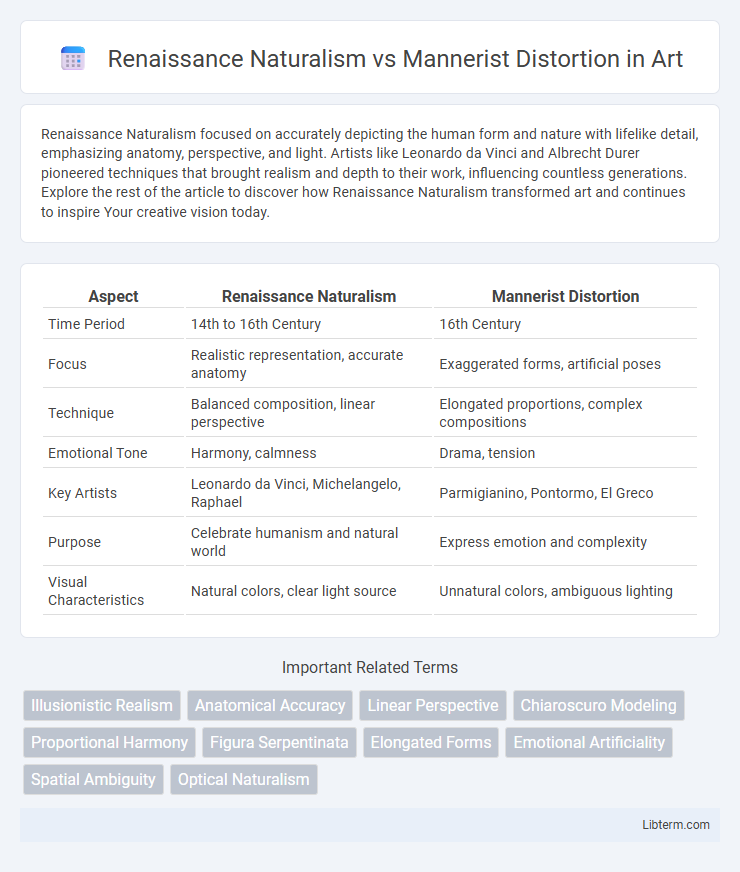Renaissance Naturalism focused on accurately depicting the human form and nature with lifelike detail, emphasizing anatomy, perspective, and light. Artists like Leonardo da Vinci and Albrecht Durer pioneered techniques that brought realism and depth to their work, influencing countless generations. Explore the rest of the article to discover how Renaissance Naturalism transformed art and continues to inspire Your creative vision today.
Table of Comparison
| Aspect | Renaissance Naturalism | Mannerist Distortion |
|---|---|---|
| Time Period | 14th to 16th Century | 16th Century |
| Focus | Realistic representation, accurate anatomy | Exaggerated forms, artificial poses |
| Technique | Balanced composition, linear perspective | Elongated proportions, complex compositions |
| Emotional Tone | Harmony, calmness | Drama, tension |
| Key Artists | Leonardo da Vinci, Michelangelo, Raphael | Parmigianino, Pontormo, El Greco |
| Purpose | Celebrate humanism and natural world | Express emotion and complexity |
| Visual Characteristics | Natural colors, clear light source | Unnatural colors, ambiguous lighting |
Introduction to Renaissance Naturalism and Mannerist Distortion
Renaissance Naturalism emphasizes accurate representation of the human form and realistic spatial depth, grounded in observation and anatomical precision. Mannerist Distortion, emerging after the High Renaissance, deliberately exaggerates proportions and perspective to create tension and emotional complexity. These contrasting approaches reflect a shift from harmonious realism to expressive ambiguity in art history.
Historical Context: Renaissance vs. Mannerism
Renaissance Naturalism emerged during the 15th and early 16th centuries, emphasizing accurate anatomical representation, balanced composition, and harmonious proportions grounded in classical antiquity. Mannerist Distortion arose in the later 16th century as a reaction to Renaissance ideals, featuring elongated figures, exaggerated poses, and complex compositions that conveyed tension and emotion. The shift reflects broader historical changes, including religious turmoil and the Sack of Rome in 1527, which influenced artists to explore more expressive and stylized forms.
Key Characteristics of Renaissance Naturalism
Renaissance Naturalism emphasizes accurate human anatomy, proportion, and perspective, reflecting a deep study of nature and classical antiquity. It features balanced composition, realistic light and shadow, and lifelike expressions that convey calm and idealized beauty. This artistic approach seeks harmony and clarity, contrasting sharply with the exaggerated poses and emotional intensity of Mannerist distortion.
Hallmarks of Mannerist Distortion
Mannerist distortion is characterized by elongated proportions, exaggerated poses, and complex compositions that defy naturalistic balance and harmony found in Renaissance naturalism. Artworks often display artificiality and tension through twisted figures and ambiguous spatial relationships, emphasizing emotional intensity over anatomical accuracy. This stylistic approach highlights distortion as a deliberate tool to evoke drama and intellectual engagement rather than realistic representation.
Influential Artists: From Leonardo to Pontormo
Leonardo da Vinci exemplified Renaissance Naturalism with his precise anatomical studies and lifelike expressions, emphasizing balanced composition and realistic proportions. In contrast, Pontormo, a key Mannerist artist, introduced exaggerated poses and elongated figures, creating tension and emotional intensity through deliberate distortion. This shift from harmony to expressive distortion marks the evolution from Renaissance ideals to Mannerist experimentation in art.
Techniques and Aesthetic Approaches Compared
Renaissance naturalism emphasizes accurate anatomical proportions, perspective, and chiaroscuro to achieve lifelike representation, with artists like Leonardo da Vinci and Raphael prioritizing harmony and balance. Mannerist distortion, by contrast, deliberately exaggerates figures and spatial relationships to evoke tension and emotional intensity, employing elongated limbs, compressed space, and heightened color contrasts as seen in works by Pontormo and Parmigianino. These divergent techniques reflect opposing aesthetic approaches: Renaissance art aims for idealized realism while Mannerism embraces artificiality and complexity to challenge viewer perception.
Human Anatomy: Realism vs. Exaggeration
Renaissance Naturalism emphasizes accurate human anatomy, capturing lifelike proportions and detailed musculature based on direct observation and study of the human body. Mannerist Distortion, conversely, exaggerates anatomical features with elongated limbs, twisted poses, and unnatural proportions to evoke emotion and complexity beyond realistic representation. This contrast highlights the Renaissance commitment to realism against Mannerism's focus on artistic expression and stylized forms.
Symbolism and Emotional Expression
Renaissance Naturalism emphasizes accurate anatomical representation and balanced composition to convey symbolism through realistic human forms, reflecting harmony and divine order. Mannerist Distortion distorts proportions and poses to enhance emotional expression and create complex symbolic meanings, often evoking tension and ambiguity. Both styles use symbolism deliberately, but while Renaissance works aim for clarity and idealized beauty, Mannerist art explores psychological depth and exaggerated emotion.
Legacy and Impact on Later Art Movements
Renaissance Naturalism, characterized by precise anatomical representation and harmonious perspective, set a foundational standard for realism that deeply influenced Baroque and Neoclassical art movements. Mannerist Distortion, with its elongated figures and exaggerated poses, challenged traditional naturalism, inspiring later Expressionism and Surrealism through its exploration of emotional intensity and abstract form. Both styles collectively expanded the boundaries of artistic expression, shaping the evolution of Western art by balancing technical mastery with imaginative innovation.
Conclusion: Enduring Significance and Divergent Ideals
Renaissance Naturalism emphasizes accurate anatomy, balanced composition, and realistic representation, highlighting the human experience through harmony and proportion. Mannerist Distortion challenges these ideals with exaggerated poses, elongated forms, and ambiguous spatial relationships, reflecting complexity and emotional tension. The enduring significance of both styles lies in their divergent expression of human creativity--Renaissance Naturalism celebrates order and clarity, while Mannerism embraces ambiguity and artistic innovation.
Renaissance Naturalism Infographic

 libterm.com
libterm.com